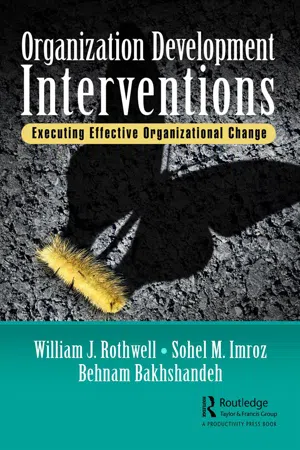
Organization Development Interventions
Executing Effective Organizational Change
- 340 pages
- English
- ePUB (mobile friendly)
- Available on iOS & Android
Organization Development Interventions
Executing Effective Organizational Change
About this book
To effectively adapt and thrive in today's business world, organizations need to implement effective organizational development (OD) interventions to improve performance and effectiveness at the individual, group, and organizational levels. OD interventions involve people, trust, support, shared power, conflict resolution, and stakeholders' participation, just to name a few. OD interventions usually have broader scope and can affect the whole organization. OD practitioners or change agents must have a solid understanding of different OD interventions to select the most appropriate one to fulfill the client's needs. There is limited precise information or research about how to design OD interventions or how they can be expected to interact with organizational conditions to achieve specific results.
This book offers OD practitioners and change agents a step-by-step approach to implementing OD interventions and includes example cases, practical tools, and guidelines for different OD interventions. It is noteworthy that roughly 65% of organizational change projects fail. One reason for the failure is that the changes are not effectively implemented, and this book focuses on how to successfully implement organizational changes.
Designed for use by OD practitioners, management, and human resources professionals, this book provides readers with OD basic principles, practices, and skills by featuring illustrative case studies and useful tools. This book shows how OD professionals can actually get work done and what the step-by-step OD effort should be. This book looks at how to choose and implement a range of interventions at different levels. Unlike other books currently available on the market, this book goes beyond individual, group, and organizational levels of OD interventions, and addresses broader OD intervention efforts at industry and community levels, too. Essentially, this book provides a practical guide for OD interventions. Each chapter provides practical information about general OD interventions, supplies best practice examples and case studies, summarizes the results of best practices, provides at least one case scenario, and offers at least one relevant tool for practitioners.
Frequently asked questions
- Essential is ideal for learners and professionals who enjoy exploring a wide range of subjects. Access the Essential Library with 800,000+ trusted titles and best-sellers across business, personal growth, and the humanities. Includes unlimited reading time and Standard Read Aloud voice.
- Complete: Perfect for advanced learners and researchers needing full, unrestricted access. Unlock 1.4M+ books across hundreds of subjects, including academic and specialized titles. The Complete Plan also includes advanced features like Premium Read Aloud and Research Assistant.
Please note we cannot support devices running on iOS 13 and Android 7 or earlier. Learn more about using the app.
Information
Foundations | I |
Chapter 1
Contents
Vignettes
Vignette One
Vignette Two
Vignette Three
Vignette Four
Summary
What Is an OD Intervention?


OD Interventions Are Implemented in Ways Consistent with OD Values and Assumptions
- Belief in human dignity
- Respect for individuals
- Belief in the importance of participation
- Belief that people should be mindful of how their actions can be perceived
- Permits people to act as humans rather than play a part as mere economic resources
- Allows people to realize their capabilities
- Emphasizes effectiveness (doing the right things) over efficiency (doing things right)
- Builds a highly engaging and highly involving corporate culture
- Gives workers voice in decisions affecting them
- Pays attention to worker individuality rather than treating people using “one-size-fits-all” approaches
- The best experts to solve problems in an organization are not external experts but rather the people within the organization.
- The biggest problem...
Table of contents
- Cover
- Half Title
- Title Page
- Copyright Page
- Dedication
- Contents
- Preface
- Acknowledgments
- Editor and Author Biosketches
- Advance Organizer
- PART I: FOUNDATIONS
- PART II: INDIVIDUAL AND SMALL-GROUP INTERVENTIONS
- PART III: INTERMEDIATE AND LARGE INTERVENTIONS
- PART IV: THE FUTURE
- Appendix A: Selected Resources to Support OD Intervention Implementation and Related Topics
- Index